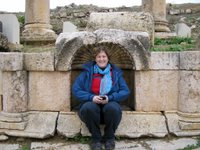Jerash and Mt. Nebo – 9th January, 2006
This morning dawned bright and sunny, quite a contrast to the heavy rain and cold weather yesterday. The early part of the morning was taken up with tour administration, but around 10am we were on our way to the Roman site of Jerash, about 40km from Amman. We didn’t think we’d have time to visit Jerash, but we decided to skip a walking tour of Amman this morning to ensure we could visit the site.
We’re both very glad that we did! Jerash is one of the best ancient sites I have ever visited. Parts of it are mostly complete, allowing a very good idea of the way the town operated and what the buildings looked like. We hired a guide to take us around the site, which was very beneficial. He gave a lot of background about different buildings and more general Roman history, which Fletch found particularly useful. We had a really good walk all over the site and enjoyed the climb up to the Temple of Artemis, where we saw the ‘shaky columns’. These are 2000-year-old earthquake-proof columns, still standing in their original spot. The way they were built allows the columns to ‘shake’ with the movement of the earth (and the wind) but they don’t fall over. I think 2000 years staying upright is pretty good going!
The real highlight of the visit for Fletch, however, was the big amphitheatre. He was stunned to discover the unique acoustical properties of the building. He stood in the middle of the amphitheatre and spoke and could be heard from everywhere in the theatre. The design of the theatre created focussed beams of sound, designed to amplify the spoken word to the back of the theatre. The most fascinating element of the design were circular ports built into the base of the amphitheatre seating – when we sat on opposite sides of the theatre and whispered into the ports, we could hear each other perfectly. It was really quite astonishing.
We wished that we could have spent more time at Jerash, but had to return to Amman to join the rest of the group on a trip to Mt. Nebo. The first stop on our way there was at Madaba, which is famous for the mosaics found in the Church of St. George. The most impressive one is on the floor near the altar, and it is a map of the Holy Land. When we first looked at it, we couldn’t make head or tail of the map. However, once we got an explanatory plan for the map, it all made sense.
From Madaba, we drove up Mt. Nebo, which is where Moses glimpsed the Promised Land before he died. There is a little church built on the top of the mountain, which Pope JPII visited in 2001. The church is covered in mosaics, both on floor and walls. It also had stunning stained glass windows around the altar. Outside the church it was possible to see the Dead Sea, but haze prevented us from seeing much more.
As we left Mt. Nebo, I asked our driver if we could visit the Church of Sts Lot and Procopius on our way back to Amman. A stunning mosaic from this church was featured on our entry ticket to Mt. Nebo, so I wanted to see it in person. The minibus drove down the mountain along a little goat track and stopped outside a cottage in the middle of nowhere. We all looked a bit confused, but the driver kept insisting this was the church. We got out of the bus while a man came from a nearby house and opened the door of the cottage. Inside, there was a mosaic floor, but we couldn’t see the panel featured on the ticket. The man who opened the door for us explained that this building had been his grandfather’s home, and that the mosaic floor had been discovered under the fireplace. When it was excavated, the archaeologists decided that it had been a church and the building is now consecrated ground. However, we couldn’t see the panel featured on the ticket, so asked him to point it out. This required standing on tiptoe, looking over a stone step and seeing one corner of the panel. I have no idea how they managed to get the panel on the ticket looking so good, because on the floor it was quite unremarkable.
(N.B. When we entered the Dead Sea resort on January 10th, we were greeted with the sight of a large replica of the panel from the Church of Sts Lot and Procopius. I believe this is the stunning mosaic represented on the Mt. Nebo ticket).
We returned to Amman in the early evening and had a nice dinner. Compared to Syria, food here is very expensive. In fact, everything here is very expensive – the Jordanian dinar is almost the equivalent of an English pound. Tomorrow we’re off to the Dead Sea, which will be fun and, hopefully, warm.
Fletch’s tips for new travellers
The bagpipes have often been only half jokingly referred to as a weapon of war employed by the Scottish. I was therefore surprised to find that the Jordanians apparently have a highland regiment! The ‘entertainment’ provided in the amphitheatre in Jarash consisted of 2 bagpipe players and a drummer in military regalia. It is possible that they were taught how to play their instruments, if you allow for the fact that they didn’t seem to know any of the same tunes. They nevertheless played simultaneously (if not harmoniously) and very enthusiastically. I think what this proves is that the Jordanian army is quite capable of taking western weaponry and making it even more offensive!
No comments:
Post a Comment